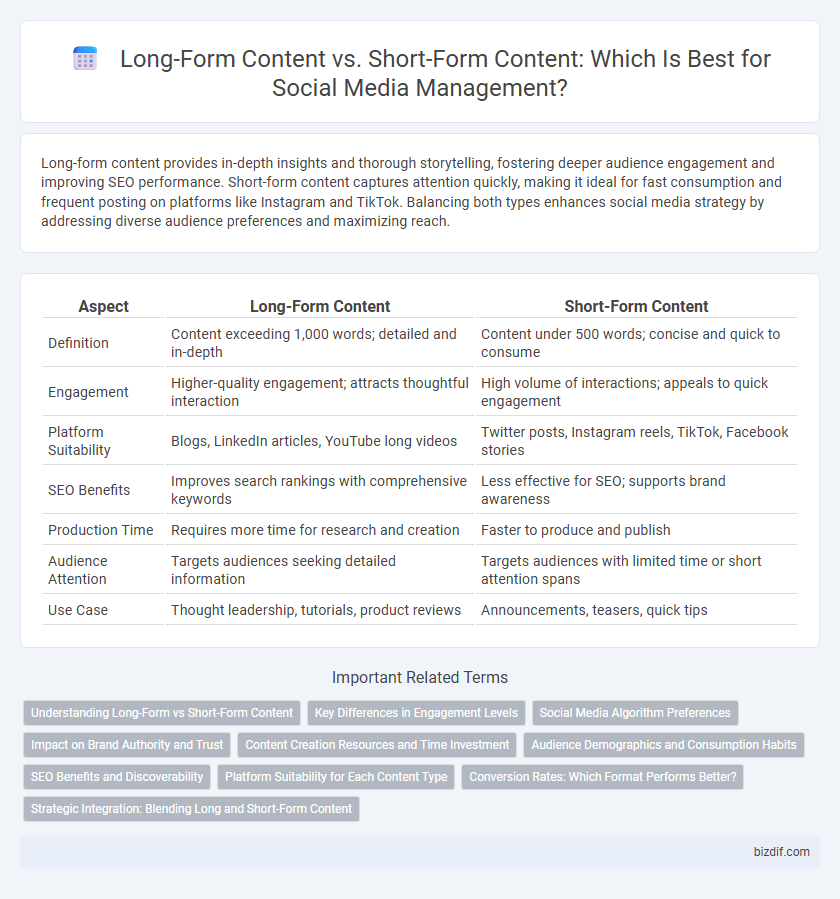Long-form content provides in-depth insights and thorough storytelling, fostering deeper audience engagement and improving SEO performance. Short-form content captures attention quickly, making it ideal for fast consumption and frequent posting on platforms like Instagram and TikTok. Balancing both types enhances social media strategy by addressing diverse audience preferences and maximizing reach.
Table of Comparison
| Aspect | Long-Form Content | Short-Form Content |
|---|---|---|
| Definition | Content exceeding 1,000 words; detailed and in-depth | Content under 500 words; concise and quick to consume |
| Engagement | Higher-quality engagement; attracts thoughtful interaction | High volume of interactions; appeals to quick engagement |
| Platform Suitability | Blogs, LinkedIn articles, YouTube long videos | Twitter posts, Instagram reels, TikTok, Facebook stories |
| SEO Benefits | Improves search rankings with comprehensive keywords | Less effective for SEO; supports brand awareness |
| Production Time | Requires more time for research and creation | Faster to produce and publish |
| Audience Attention | Targets audiences seeking detailed information | Targets audiences with limited time or short attention spans |
| Use Case | Thought leadership, tutorials, product reviews | Announcements, teasers, quick tips |
Understanding Long-Form vs Short-Form Content
Long-form content typically exceeds 1,200 words and provides in-depth analysis, making it ideal for SEO and establishing authority, while short-form content ranges from a few seconds to under 1,000 words, focusing on quick engagement and shareability on platforms like Instagram and Twitter. Understanding the strengths of each format helps tailor social media strategies by balancing comprehensive storytelling with concise messaging to maximize audience reach and interaction. Prioritizing format selection based on platform algorithms and target demographics enhances content performance and brand visibility.
Key Differences in Engagement Levels
Long-form content drives deeper user engagement through comprehensive storytelling, offering in-depth information that encourages longer reading times and higher retention rates on platforms like blogs and LinkedIn. Short-form content, prevalent on Twitter and Instagram, generates quick interactions such as likes, shares, and comments due to its concise and easily consumable nature. Engagement metrics for long-form content typically show increased time spent and repeat visits, whereas short-form content excels in rapid reach and viral potential.
Social Media Algorithm Preferences
Social media algorithms prioritize engagement metrics differently for long-form and short-form content, often favoring short-form due to its higher shareability and quick consumption value on platforms like TikTok and Instagram Reels. Long-form content, prevalent on YouTube and Facebook, benefits from deeper watch time and comprehensive user interaction signals that boost algorithmic ranking. Understanding platform-specific preferences is crucial for optimizing reach and maintaining audience retention across social channels.
Impact on Brand Authority and Trust
Long-form content enhances brand authority by providing in-depth knowledge, fostering trust through comprehensive and well-researched information that positions the brand as an expert. Short-form content boosts engagement and brand visibility by delivering concise, impactful messages tailored to fast-paced social media consumption, reinforcing brand consistency. Balancing both formats allows brands to build sustained credibility while maintaining audience attention across multiple platforms.
Content Creation Resources and Time Investment
Long-form content requires substantial content creation resources and a significant time investment due to extensive research, writing, and editing processes. Short-form content demands fewer resources and less time, making it ideal for frequent posting and quick audience engagement. Efficient allocation of time and resources is crucial in social media management to balance the benefits of both long-form and short-form content.
Audience Demographics and Consumption Habits
Long-form content appeals primarily to audiences seeking in-depth information, often attracting older demographics and professionals who consume content during dedicated sessions. Short-form content resonates with younger audiences, such as Gen Z and Millennials, who prefer quick, easily digestible posts suited for mobile consumption and frequent scrolling. Understanding these consumption habits enables social media managers to tailor strategies that maximize engagement based on platform-specific user behaviors and demographic preferences.
SEO Benefits and Discoverability
Long-form content enhances SEO benefits by providing in-depth information, increasing keyword density, and encouraging longer user engagement, which improves search engine rankings. Short-form content boosts discoverability on social media platforms through quick consumption, higher shareability, and frequent posting, driving immediate traffic and brand visibility. Combining both strategies optimizes overall content performance by addressing diverse audience preferences and search algorithms.
Platform Suitability for Each Content Type
Long-form content thrives on platforms like YouTube and LinkedIn, where audiences seek in-depth information and detailed storytelling, making it ideal for educational videos and comprehensive articles. Short-form content excels on Instagram, TikTok, and Twitter, capturing attention quickly through bite-sized videos, memes, and concise posts that encourage engagement and sharing. Understanding platform algorithms and user behavior is crucial for optimizing reach and effectively targeting different audience segments with the appropriate content length.
Conversion Rates: Which Format Performs Better?
Long-form content typically achieves higher conversion rates by providing in-depth information and building trust with the audience, which is crucial for complex products or services. Short-form content excels at capturing attention quickly, making it effective for driving immediate actions like clicks or sign-ups in fast-paced social media environments. Businesses should align content length with their conversion goals, considering factors like audience behavior and platform algorithms to optimize engagement and sales.
Strategic Integration: Blending Long and Short-Form Content
Strategic integration of long-form and short-form content enhances social media engagement by balancing depth and brevity to cater to diverse audience preferences. Long-form content such as blog posts and detailed videos builds authority and provides comprehensive insights, while short-form content including reels, stories, and tweets drives immediate interaction and shareability. Combining these formats maximizes reach and retention, ensuring a cohesive brand narrative across platforms like Instagram, TikTok, and LinkedIn.
Long-form content vs short-form content Infographic

 bizdif.com
bizdif.com